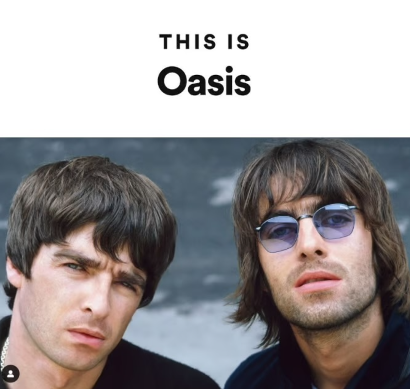
On August 26, exciting news spread across the world as Oasis’s official Twitter account announced their comeback, sending fans into a frenzy. Oasis, who had been mainly active through solo projects due to internal conflicts among the members, announced their return to the stage as a band. Despite more than a decade having passed since Oasis was in its prime, the band still garners an enthusiastic response not only from their original fans but also from younger generations. What is it about Oasis that continues to captivate people today? To understand this, we need to explore the history of the band and the Britpop movement with Oasis’s story.
In 1967, a movement known as the “Summer of Love” began in San Francisco, USA, where a sense of community flourished around the hippie culture. A second “Summer of Love” hit the UK between 1988 and 1990. This era was marked by the rise of rave culture, which revolved around parties fueled by ecstasy (a stimulant and hallucinogenic drug) and spontaneous techno music that kept people dancing all night long. While some disapproved of the wild partying, the younger generation embraced it, and the UK experienced a passionate, love-filled summer reminiscent of the original “Summer of Love.”
However, when news broke of a girl, Claire Leighton, who died after taking ecstasy that her boyfriend had given her , the UK government began to crack down on rave culture. Despite efforts to control it, the movement didn’t vanish easily and later evolved into what was known as the Madchester scene, a mix of dance music and baggy rock. Two brothers from Manchester were swept up in this scene, but Madchester couldn’t escape the influence of ecstasy, and soon, a void was left in the UK music scene.
This void was filled by the American band Nirvana, whose pessimistic music didn’t sit well with some British music fans. Although there weren’t many British bands to challenge Nirvana’s dominance, the arrival of the band Suede brought a breath of fresh air with its upbeat music, igniting excitement in the UK music scene once again. Around the same time, another band called Blur entered the American market, but quickly shifted their focus back to the UK music scene, recognizing the need for British bands to take center stage.
Then came Oasis. Formed in 1991, Oasis took their time preparing their debut album while performing at various gigs. They eventually caught the attention of Creation Records, the top indie label at the time, and signed a contract, setting the stage for their official debut. One notable factor that helped Oasis rise to fame was a major shake-up at BBC Radio 1, where young producers started introducing what would later be known as Britpop to the airwaves. Oasis benefited greatly from this exposure, and in 1994, they made a spectacular debut with their album Definitely Maybe. Filled with a thirst for life and a fresh Rock & Roll sound reminiscent of The Beatles, this album bridged the gap between generations through its timeless music. And there was a surprising story with Blur.
Both Oasis and Blur were part of Britpop, they couldn’t have been more different. Blur, formed in London, represented the British middle class with their clever, satirical lyrics about British life. Their sound was experimental and drew from a range of influences, which made them a favorite among critics. Oasis, on the other hand, came from the working-class city of Manchester. The band, led by the Gallagher brothers, Noel and Liam, embodied the grit and bravado of working-class life. Their anthemic songs like “Wonderwall” and “Don’t Look Back in Anger” were straightforward, catchy, and deeply emotional, capturing the hearts of fans looking for raw, unapologetic music.
The rivalry really took off in 1995 when Blur and Oasis both released singles on the same day. Blur moved the release of their single “Country House” to coincide with Oasis’s “Roll With It,” pitting the bands directly against each other in a race for the top spot on the UK Singles Chart. The British press seized the opportunity, framing it as a “Battle of Britpop” and turning it into a national debate about British identity, class, and culture. Blur won the chart battle, with “Country House” outselling “Roll With It.” However, Oasis quickly bounced back. Their album (What’s the Story) Morning Glory?, released shortly after, became a massive success, ultimately outselling Blur’s album and establishing Oasis as one of the biggest bands in the world.
The feud wasn’t just about music; it got personal. The Gallagher brothers, known for their outspoken personalities, didn’t hold back in their disdain for Blur. Noel Gallagher infamously commented that he hoped Blur’s members would “catch AIDS and die,” a remark that sparked outrage and intensified the animosity between the bands. While Blur’s members took a more sarcastic approach to the rivalry, the feud often played out in interviews and the press. Fans were divided, and the Oasis vs. Blur debate became a cultural phenomenon, with people picking sides and passionately defending their favorite band.
By the late 1990s, Britpop began to fade, and so did the intensity of the rivalry. Both bands moved in different musical directions, with Blur embracing a more experimental style and Oasis doubling down on their rock roots. Over the years, tensions eased, and members from both bands acknowledged that the rivalry had been partly media-driven.
The legacy of the Oasis-Blur feud, however, remains strong. It marked a defining moment in British music history and highlighted the cultural tensions of the time. Today, the “Battle of Britpop” is remembered as a thrilling chapter in music that showcased two of Britain’s most influential bands. Despite their differences, both Oasis and Blur left an indelible mark on music, influencing countless bands and cementing their place in rock history.
Even though Oasis went on to create several more classic albums, they disbanded in 2009 due to internal disputes.
So why, after more than 15 years of hiatus, do people still go wild for Oasis? There are four key reasons:
Timeless Tracks
Oasis’s iconic albums like Definitely Maybe and (What’s the Story) Morning Glory? have continued to be beloved by fans long after the 1990s and 2000s. Songs like “Wonderwall” and “Don’t Look Back in Anger” have been covered by countless influencers and artists, keeping Oasis’s music alive and relevant even today.
Oasis Beyond the Band
Oasis didn’t just represent a musical movement—they were part of the cultural zeitgeist of the 1990s. Their rivalry with Blur captured the public’s imagination, and the Gallagher brothers, Liam and Noel, with their mischievous personas, ensured that all eyes were on them.
A Nostalgic Connection
For fans who grew up with Oasis, their return sparks a deep sense of nostalgia. The band’s comeback offers a way to relive their youth and connect to the cultural moments that defined them.
The Universal Appeal of English-Language Music
As Coldplay once mentioned in an interview, the fact that their music is in English allows it to resonate with a global audience, as English is widely understood. This linguistic accessibility is a factor in why Oasis’s lyrics and atmosphere continue to be appreciated across generations and around the world.

For fans of band music, whether it’s Oasis (오아시스), Day6 (데이식스), LUCY (루시), or Band Nah (나상현씨밴드), the reason for their love often lies in the combination of instrumental sound and vocals. Unlike much of today’s pop music, which is dominated by synthetic sounds, the rhythmic and organic sounds of a live band draw listeners in. Additionally, the allure of “minor” bands — those that aren’t as mainstream — creates a special connection with fans.
The current resurgence of retro trends has led Generation Z to discover 1990s music, while vinyl record collecting has brought back the experience of owning music. Being able to own music from before you were born adds to the excitement of enjoying bands from past eras.

In the end, Music is a reflection of the times and the artist’s experiences, shaped by themes of love, failure, passion, and youth. Oasis’s analog-style passion and youthful energy resonate even today, seamlessly blending into the ever-evolving cultural landscape. The worldwide excitement over Oasis’s comeback after years of public feuds and inactivity highlights music’s role as a living history, one that continues to evolve with each new generation.
Though music may seem like just a collection of melodies, lyrics, and vocals, the way the music industry is buzzing with Oasis’s return is a testament to how much music captures the spirit of the times and creates its own unique atmosphere. If we broaden our listening beyond the “current” hits to music from various eras, we can directly experience the history and culture of the people who lived through those times. How about taking this opportunity to explore the music of different generations and appreciate the lives and cultures they represent?

